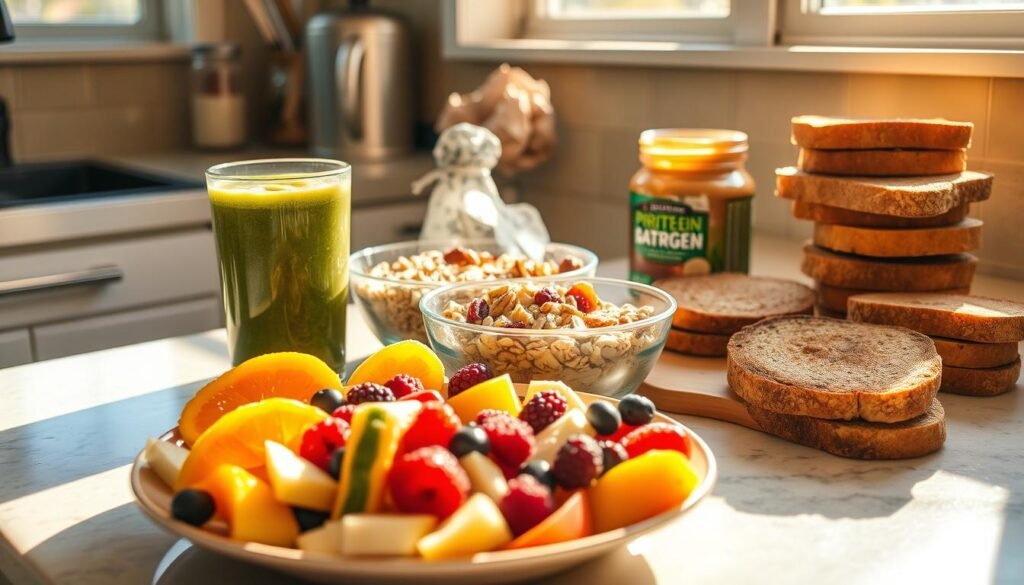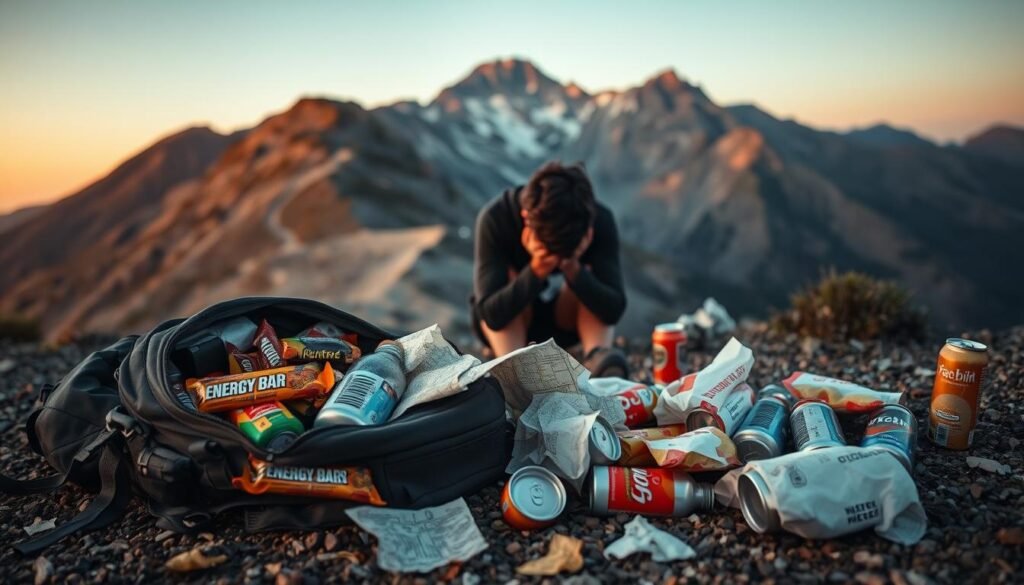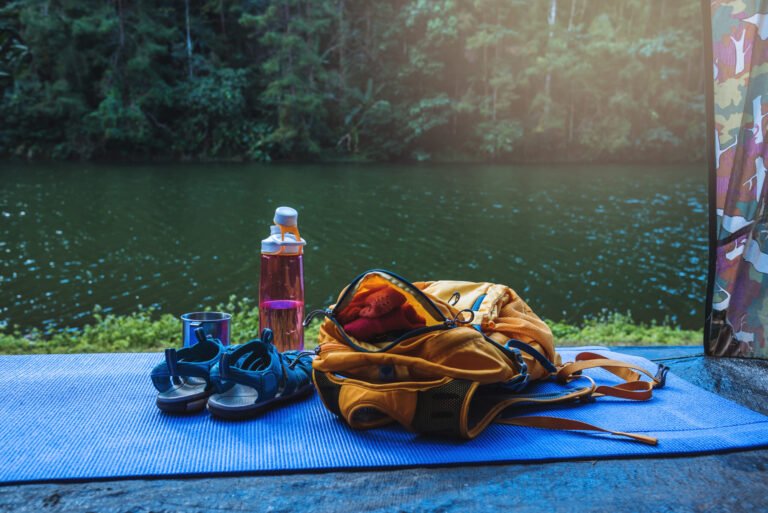Recovery Nutrition: What to Eat After a Big Hiking Day
Maximize your post-hike recovery with our expert Recovery Nutrition guide. Find out what to eat and when to replenish energy stores and support muscle repair.
After a long hike, your body needs the right fuel to bounce back. Proper post-hike meals help repair muscles, restore energy, and reduce soreness. Whether you’re tackling steep trails or covering miles, smart food choices make a difference. Understanding Recovery Nutrition is key to optimizing your post-hike recovery.

Experts recommend a mix of protein and carbs within 45–60 minutes of finishing your hike. This supports muscle repair and replenishes glycogen stores. Hydration is just as crucial—replace fluids and electrolytes lost during exercise.
For best results, follow the 4R’s framework: Rehydrate, Refuel, Repair, and Rest. A balanced approach ensures your body recovers efficiently through proper Recovery Nutrition. Learn more about post-hike meal ideas to maximize your performance.
Key Takeaways
- Protein (20–40g) helps rebuild muscles after strenuous hikes.
- Carbs restore energy lost during endurance activities.
- Hydration with electrolytes prevents fatigue and cramps.
- The 4R’s model ensures a complete recovery strategy.
- Timing matters—eat within the first hour for best results.
Why Post-Hike Nutrition Matters
Science shows that strategic eating after hiking significantly impacts muscle repair and energy levels. The right nutrients help your body adapt to physical stress and prepare for future adventures.
The Science Behind Muscle Repair
Protein triggers muscle protein synthesis (MPS), rebuilding fibers damaged during hikes. Experts recommend 1.2–1.6g/kg daily for active individuals to maximize repair.
Carbs play an equally vital role. A 2020 study found that 120g of carbs hourly improved recovery in ultra-endurance athletes by restoring glycogen 40% faster.
How Food Accelerates Healing
Implementing effective Recovery Nutrition strategies can enhance your overall recovery process.
Smart intake leverages your body’s metabolic processes:
- Omega-3 fats reduce inflammation, easing joint and muscle soreness.
- Polyphenols (like quercetin) combat oxidative stress from prolonged exertion.
- Timing matters—eating within 60 minutes boosts anabolic signaling for efficient repair.
These strategies work synergistically to shorten downtime and enhance performance.
Macronutrients for Post-Hike Recovery
The right balance of macronutrients can speed up your post-hike healing process. Protein, carbs, and fats each play unique roles in repairing muscles, refueling energy, and reducing inflammation. Choosing the right foods ensures your body gets what it needs to bounce back stronger.
Protein: Repairing and Building Muscle
Protein is essential for fixing muscle damage caused by long hikes. A 2006 study found whole milk outperformed skim milk in promoting muscle growth due to its balanced nutrients. Aim for 20–40g of high-quality protein like chicken, eggs, or Greek yogurt post-hike.
Carbohydrates: Replenishing Energy Stores
Carbs restore glycogen, your body’s primary energy source during hikes. Quick-digesting options like bananas or sweet potatoes work best within the first hour. Pair them with protein to maximize absorption and metabolism efficiency.
Fats: Supporting Overall Recovery
Healthy fats reduce exercise-induced inflammation. Omega-3s (found in chia seeds and walnuts) and MCTs (in coconut oil) convert to energy fast. A 2020 study linked olive oil to reduced muscle damage in marathon runners.
- Best post-hike fats: Almonds, avocados, extra virgin olive oil (EVOO).
- Avoid: Trans fats in processed snacks—they slow healing.
- Timing tip: Combine fats with carbs/protein for better nutrient uptake.
Balancing these nutrients in the right amounts supports overall health and prepares you for your next adventure.
Hydration: The First Step to Recovery
Staying hydrated isn’t just about drinking water—it’s about balance. After a hike, your body needs fluids and electrolytes to function properly. Ignoring hydration can lead to fatigue, cramps, and slower recovery.
Electrolytes and Their Role
Electrolytes like sodium, potassium, and magnesium help regulate muscle and nerve function. A 2020 study found that hikers who replaced lost electrolytes recovered 30% faster than those who drank plain water.
- Sweat rate: Calculate it by (pre-hike weight – post-hike weight) + fluid intake.
- Altitude: Above 8,000 feet, you lose fluids faster due to increased respiration.
- Caffeine: Post-hike beers or coffee have a mild diuretic effect—limit intake.
How Much Water to Drink
The National Athletic Trainers’ Association (guidelines) recommends 200–300ml every 10–20 minutes during activity. After hiking, aim to replace 150% of lost weight within 4 hours.
| Urine Color | Hydration Level |
|---|---|
| Pale yellow | Optimal |
| Dark yellow | Mild dehydration |
| Amber | Severe dehydration |
For hikes over 2 hours, choose electrolyte-enhanced waters or tablets. Hydration packs are ideal for steady sipping, while bottles work for shorter trails.
Timing Your Post-Hike Meals
Eating at the right intervals post-hike maximizes muscle repair and energy restoration. Your body’s ability to absorb nutrients peaks within specific windows, making timing a critical factor in recovery.
The Anabolic Window: Myth or Fact?
Debates swirl around the “anabolic window”—the idea that you must eat within 30–60 minutes post-hike. Recent studies suggest a broader 2-hour window for optimal intake. A 2022 meta-analysis found no significant difference in muscle growth when protein was consumed immediately vs. within 2 hours.
Optimal Meal Timing for Hikers
Follow this phased approach to align with your body’s needs:
| Phase | Timeframe | Goal | Food Examples |
|---|---|---|---|
| Immediate | 0–2 hours | Replenish glycogen, reduce soreness | Smoothies, chocolate milk, bananas |
| Intermediate | 2–6 hours | Sustain repair processes | Grilled chicken, quinoa, roasted veggies |
| Long-term | 6–24 hours | Restore energy fully | Salmon, sweet potatoes, avocado |
For multi-day hikes, constant feeding (small, frequent meals) works better than large, spaced-out meals. Portable snacks like trail mix or protein bars keep energy steady.
- Liquid nutrition: Smoothies digest faster than solids, ideal for immediate post-hike activity.
- Circadian rhythm: Evening hikes? Prioritize protein-heavy meals to overnight muscle repair.
- Backcountry tips: Pack dehydrated meals with a 3:1 carb-to-protein ratio for lightweight fueling.
Adjust your diet based on hike intensity. A 10-mile trek demands quicker refueling than a casual 3-mile walk.
Best Foods for Post-Hike Recovery
Choosing the right post-hike foods can make or break your recovery process. Focus on options rich in protein, carbs, and healthy fats to repair muscles and restore energy. These nutrients work together to reduce inflammation and speed up healing.
High-Protein Options
Protein rebuilds muscle fibers stressed during hikes. Aim for 20–40g per meal from sources like grilled chicken, Greek yogurt, or lentils. For convenience, pack single-serve tuna packets or jerky for backcountry trips.
Carb-Rich Foods for Energy
Carbs replenish glycogen stores burned during long hikes. Quick-digesting options like bananas or white rice are ideal within the first hour. For sustained energy, try quinoa or whole-grain wraps with hummus.
Healthy Fats to Include
Not all fats are equal. Prioritize omega-3s (walnuts, chia seeds) to combat inflammation. MCT oil, derived from coconut oil, boosts ketone production—a study showed it enhances post-exercise health markers.
| Nut Butter | Omega-3:6 Ratio | Best For |
|---|---|---|
| Almond | 1:2000 | Quick energy |
| Macadamia | 1:6 | Balanced fats |
| Sunflower | 1:312 | Allergy-friendly |
- Heat-stable fats: Coconut oil and ghee won’t spoil in your pack.
- Seed cycling: Flaxseeds support hormonal balance during multi-day treks.
- Avocado packets: Portable and rich in monounsaturated fats.
Tailor your post-hike diet to your activity level. A mix of these foods ensures your body gets what it needs to recover efficiently.
Sample Post-Hike Meals and Snacks
Smart post-hike meals can turn fatigue into renewed energy. Focus on easy-to-prepare options that balance protein, carbs, and fats. These choices support muscle repair and keep you ready for your next adventure.
Quick and Easy Meal Ideas
Chocolate milk is a classic recovery drink with a 3:1 carb-to-protein ratio. It’s fast, hydrating, and research-backed. For heartier options, try:
- Scrambled eggs with whole-grain toast and avocado.
- Quinoa bowls with roasted veggies and grilled chicken.
- Pre-packaged dehydrated meals for backcountry convenience.
Snacks for On-the-Go Recovery
Trail mix with nuts and seeds offers portable nutrition. Compare popular protein bars:
| Brand | Protein (g) | Carbs (g) |
|---|---|---|
| RxBar | 12 | 23 |
| Epic | 10 | 8 |
| CLIF | 9 | 44 |
Other shelf-stable snacks:
- Homemade energy balls (dates + whey protein).
- Pickle juice shots for electrolytes.
- Biltong or roasted chickpeas for savory cravings.
Supplements for Enhanced Recovery
Supplements can give your post-hike repair an extra edge when food alone isn’t enough. Science-backed options like creatine and amino acids support muscle repair, energy restoration, and overall performance.
Whey Protein and Its Benefits
Whey protein digests quickly, making it ideal for post-hike muscle synthesis. A 30g serving provides essential amino acids, particularly leucine, which triggers muscle growth. For lactose-sensitive hikers, plant-based alternatives like pea protein offer similar benefits.
Creatine and Amino Acids
Creatine is a game-changer for endurance. Research shows 5g daily boosts strength by 14% by replenishing ATP (energy molecules) during intense activity. Vegan hikers may need supplements since natural sources (like red meat) are limited.
Amino acids also play key roles:
- Beta-alanine: Buffers muscle acidity, delaying fatigue during long treks.
- HMB (3g/day): Reduces muscle breakdown, especially useful for multi-day hikes.
- BCAAs vs EAAs: Essential amino acids (EAAs) outperform branched-chain (BCAAs) for full muscle repair.
“10g of arginine pre-workout enhances endurance by improving blood flow to muscles.”
Pair these supplements with whole foods for balanced effects. Always consult a healthcare provider before starting new regimens, especially for multi-day adventures.
Recovery Nutrition for Endurance Hikers
Endurance hikers face unique challenges when refueling after long treks. Multi-day adventures demand careful planning to maintain energy and support muscle repair. Unlike single-day hikes, extended trips require special strategies to prevent fatigue and optimize performance.
Special Considerations for Long Treks
For multi-day hikes, your body needs higher amounts of fuel. The International Society of Sports Nutrition recommends 8-12g of carbs per kg of body weight daily for extreme activity. This prevents energy crashes during consecutive day hikes.
Follow this 7-day meal framework:
- Breakfast: Oatmeal with nut butter and dried fruit
- Lunch: Whole-grain wraps with tuna and avocado
- Dinner: Dehydrated meals with 3:1 carb-to-protein ratio
- Snacks: Trail mix, protein bars, and electrolyte chews
Protein pacing is crucial—aim for 20-30g every 3-4 hours. This maintains muscle synthesis throughout the day.
Adjusting Intake for Multi-Day Hikes
Your digestive system works harder at altitude. A 2:1 glucose-fructose mix prevents GI distress during long intake periods. Pack recovery smoothie powders for easy resupply at trail stops.
Don’t overlook micronutrients:
| Nutrient | Benefit | Sources |
|---|---|---|
| Iron | Oxygen transport | Spinach, lentils, red meat |
| Zinc | Immune support | Pumpkin seeds, oysters |
| Vitamin D | Bone health | Egg yolks, fortified foods |
Probiotics support gut health when eating unfamiliar trail foods. Look for shelf-stable options like fermented nut cheeses or supplement packets.
Common Mistakes to Avoid
Many hikers unknowingly sabotage their recovery with simple mistakes. Poor timing or skipping essentials like hydration and meals can delay healing and hurt performance. Learn how to dodge these pitfalls for faster results.

1. Overlooking Hydration
Dehydration sneaks up fast. Symptoms like headaches or cramps signal trouble. A study found delayed intake cuts glycogen synthesis by 50%, slowing energy restoration.
Spot and fix dehydration:
| Symptom | Solution |
|---|---|
| Dry mouth | Sip 16oz water per pound lost |
| Muscle cramps | Add electrolytes (e.g., coconut water) |
| Fatigue | Pair fluids with carbs |
At altitude, drink 1.5x more. Your body adapts poorly to chronic fluid deficits, risking health long-term.
2. Skipping Post-Hike Meals
Ignoring meals triggers muscle breakdown. Chronic underfueling leads to RED-S, a condition harming bone density and immunity. Structured refeeding prevents this.
Altitude suppresses appetite. Try these calorie-dense snacks:
- Nut butter packets: 200+ calories per serving.
- Dark chocolate: Quick energy + antioxidants.
- Cheese sticks: Portable protein and fats.
“Hikers at 10,000+ feet burn 30% more calories but eat 40% less due to appetite loss.”
Pack smart. A mix of carbs, protein, and fats keeps nutrition balanced even when hunger fades.
Conclusion
Your post-hike choices today shape tomorrow’s trail performance. Focus on protein (20–40g) to repair muscle, carbs to refuel energy, and healthy fats to reduce inflammation. Don’t forget electrolytes—they’re as vital as water.
Timing matters. Eat within 2 hours to maximize repair, following the 4R’s framework: Rehydrate, Refuel, Repair, Rest. Customize your plan based on hike intensity and personal needs.
Ready to recover smarter? Start with one strategy—like adding a post-hike smoothie—and build from there. Your body (and next hike) will thank you.




